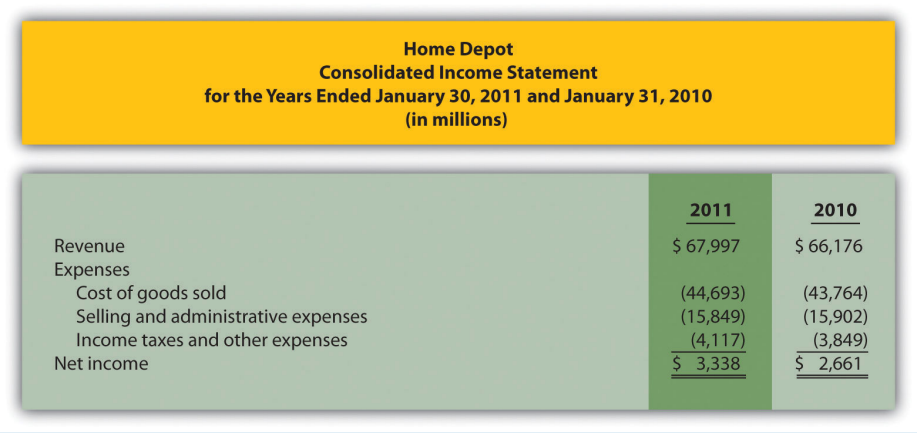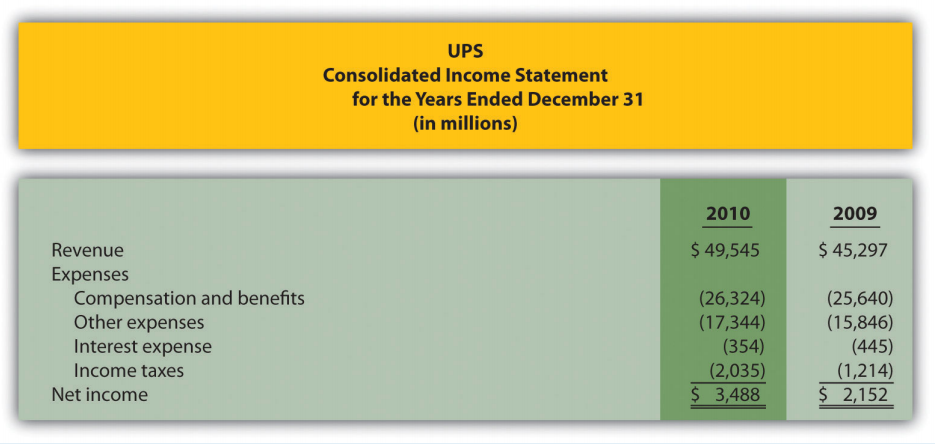11 2. Exercises (Part 2)
Exercises: Set B
- Financial Versus
Managerial Accounting (Merchandising). Home Depot’s annual report appears as follows in summary form. (This information was obtained from the company’s Web site, http://www.homedepot.com.)

Required:
- The financial information in the company’s annual report was prepared primarily for shareholders and creditors in accordance with U.S. GAAP. Does the income statement provide enough detailed information for managers at Home Depot? Explain.
- Provide at least three additional detailed pieces of financial information that would help managers evaluate performance at Home Depot.
- Provide at least two nonfinancial measures that would help managers evaluate performance at Home Depot.
- Organizational Structure. The following list of personnel within organizations comes from Figure 1.2.
- Board of directors
- Chief financial officer
-
Controller
- Managerial accountant
- Financial accountant
-
Tax accountant
-
Treasurer
-
Internal auditor
Required:
Match each previous item with the most accurate description as follows:
- Responsible for hiring and overseeing the chief executive officer
- Assists in preparing financial information for those outside the company, such as shareholders and bondholders
- Responsible for reviewing internal controls within the company and ensuring accurate financial data
- Responsible for controller, treasurer, and internal auditor functions within the organization
- Responsible for projecting cash flow needs and managing cash and short-term investments
- Oversees the managerial accountant, financial accountant, and tax accountant
- Prepares profit information by product, which is used for decision making within the organization
- Assists in establishing tax strategies for the organization.
- Schedule of Raw Materials Placed in Production. The balance in Clay Company’s raw materials inventory account was $45,000 at the beginning of April and $38,000 at the end of April. Raw materials purchased during the month totaled $55,000. Clay used $14,000 in indirect materials for the month.
Required:
Prepare a schedule of raw materials placed in production for the month of April.
- Schedule of
Cost of Goods Manufactured. The balance in the work-in-process inventory account of Verdi Production, Inc., was $900,000 at the beginning of May and $750,000 at the end of May. Manufacturing costs for the month follow.
|
Direct materials (from the schedule of raw materials placed in production)
|
$340,000 |
|
Direct labor
|
$810,000 |
|
Manufacturing overhead
|
$660,000 |
Required:
Prepare a schedule of cost of goods manufactured for the month of May.
- Schedule of Cost of Goods Sold. The balance in Posada Company’s finished goods inventory account was $650,000 at the beginning of March and $625,000 at the end of March.
Cost of goods manufactured for the month totaled $445,000.
Required:
Prepare a schedule of cost of goods sold for the month of March.
- Income Statement. Game Products, Inc., had the following activity for the month of June.
| Sales revenue | $800,000 |
| Selling expenses | $100,000 |
| General and administrative expenses | $200,000 |
|
Cost of goods sold
|
$360,000 |
Required:
Prepare an income statement for the month of June.
Problems
- Financial Versus Managerial Accounting (Service). The income statement from the annual report of United Parcel Service (UPS) appears as follows in summary form. (This information was obtained from the company’s Web site, www.ups.com.)

Required:
- The financial information in the company’s annual report was prepared primarily for shareholders and creditors in accordance with U.S. GAAP. Does the income statement provide enough detailed information for managers at UPS? Explain.
- Provide at least three additional detailed pieces of financial information that would help managers evaluate performance at UPS.
- Provide at least two nonfinancial measures that would help managers evaluate performance at UPS.
- Income Statement and Supporting Schedules. The following financial information is for Industrial Company. (Note that the most current financial information is presented in the first column.)
| December 31, 2011 | December 31, 2011 | |
|
Raw materials inventory
|
$ 24,000 | $ 30,000 |
| Work-in-process inventory | $ 1,800,000 | $ 1,650,000 |
|
Finished goods inventory
|
$ 1,050,000 | $ 1,050,000 |
Of the total raw materials placed in production for the year, $36,000 was for indirect materials. Industrial had $3,795,000 in sales for the year ended December 31, 2011. The company also had the following costs for the year:
| Selling | $ 270,000 |
| General and administrative | $ 720,000 |
| Raw materials purchases | $ 300,000 |
|
Direct labor used in production
|
$ 375,000 |
|
Manufacturing overhead
|
$1,890,000 |
Required:
- Prepare a schedule of raw materials placed in production for the year ended December 31, 2011.
- Prepare a schedule of cost of goods manufactured for the year ended December 31, 2011.
- Prepare a schedule of cost of goods sold for the year ended December 31, 2011.
- Prepare an income statement for the year ended December 31, 2011.
- Describe the three types of costs included in cost of goods sold on the income statement. (Dollar amounts are not necessary in your descriptions.)
- Income Statement and Supporting Schedules. The following financial information is for Danville Company. (Note that the most current financial information is presented in the first column.)
| December 31, 2011 | December 31, 2010 | |
|
Raw materials inventory
|
$ 8,000 | $ 8,000 |
| Work-in-process inventory | $ 600,000 | $ 550,000 |
|
Finished goods inventory
|
$ 350,000 | $ 410,000 |
Of the total raw materials placed in production for the year, $12,000 was for indirect materials. Danville had $1,265,000 in sales for the year ended December 31, 2011. The company also had the following costs for the year:
| Selling | $ 90,000 |
| General and administrative | $240,000 |
| Raw materials purchases | $100,000 |
|
Direct labor used in production
|
$125,000 |
|
Manufacturing overhead
|
$630,000 |
Required:
- Prepare a schedule of raw materials placed in production for the year ended December 31, 2011.
- Prepare a schedule of cost of goods manufactured for the year ended December 31, 2011.
- Prepare a schedule of cost of goods sold for the year ended December 31, 2011.
- Prepare an income statement for the year ended December 31, 2011.
- Describe the three types of costs included in cost of goods manufactured. (Dollar amounts are not necessary in your descriptions.)
- Income Statement and Supporting Schedules. The following information is for Ciena, Inc., for the year ended December 31, 2011.
|
Raw materials inventory beginning balance
|
$ 15,000 |
|
Raw materials inventory ending balance
|
$ 12,000 |
| Work-in-process inventory beginning balance | $ 825,000 |
| Work-in-process inventory ending balance | $ 900,000 |
|
Finished goods inventory beginning balance
|
$ 615,000 |
|
Finished goods inventory ending balance
|
$ 525,000 |
| Raw material purchases | $ 150,000 |
|
Direct labor used in production
|
$ 187,500 |
|
Manufacturing overhead
|
$ 945,000 |
|
Selling costs
|
$ 135,000 |
| General and administrative | $ 360,000 |
| Sales revenue | $1,897,500 |
Of the total raw materials placed in production for the year, $18,000 was for indirect materials.
Required:
- Prepare a schedule of raw materials placed in production for the year ended December 31, 2011.
- Prepare a schedule of cost of goods manufactured for the year ended December 31, 2011.
- Prepare a schedule of cost of goods sold for the year ended December 31, 2011.
- Prepare an income statement for the year ending December 31, 2011.
- Income Statement and Supporting Schedules. The following information is for Diablo, Inc., for the year ended December 31, 2011.
|
Raw materials inventory beginning balance
|
$ 60,000 |
|
Raw materials inventory ending balance
|
$ 48,000 |
| Work-in-process inventory beginning balance | $3,300,000 |
| Work-in-process inventory ending balance | $3,600,000 |
|
Finished goods inventory beginning balance
|
$2,460,000 |
|
Finished goods inventory ending balance
|
$2,100,000 |
| Raw material purchases | $ 600,000 |
|
Direct labor used in production
|
$ 750,000 |
|
Manufacturing overhead
|
$3,780,000 |
|
Selling costs
|
$ 540,000 |
| General and administrative | $1,440,000 |
| Sales revenue | $7,590,000 |
Of the total raw materials placed in production for the year, $72,000 was for indirect materials.
Required:
- Prepare a schedule of raw materials placed in production for the year ended December 31, 2011.
- Prepare a schedule of cost of goods manufactured for the year ended December 31, 2011.
- Prepare a schedule of cost of goods sold for the year ended December 31, 2011.
- Prepare an income statement for the year ending December 31, 2011.
One Step Further: Skill-Building Cases
- Ethics: Accounting for Obsolete Inventory. High Tech, Inc., is a public company that produces laser and ink jet printers. Jorge is an accounting staff member who works for the company’s controller and is involved in preparing the annual report. One of High Tech’s competitors developed a superior color laser jet printer using a less costly production process. Jorge realizes that High Tech’s substantial inventory of color laser jet printers is effectively obsolete and will have to be written down to its net realizable value in accordance with U.S. GAAP. This means higher expenses and lower profits. Jorge’s boss, the controller, is aware of the situation but the chief financial officer is not. In fact, the controllertold the CFO that High Tech does not have any obsolete inventory. Both Jorge’s boss and the CFO receive bonuses tied to the company’s profits. The outside auditors are completing the audit and are unaware of the obsolete inventory.
Required:
How should Jorge handle this situation? Use the IMA’s Statement of Ethical Professional Practice shown in Figure 2.2, section 2.5. as a guide to answering this question.
- Internet Project: Institute of Management Accountants. Go to the Web site of the Institute of Management Accountants (http://www.imanet.org). Review various parts of the site (e.g., About IMA or Certification) and write a one-page summary of your findings.
- Internet Project: American Institute of Certified Public Accountants. Go to the Web site of the American Institute of Certified Public Accountants (AICPA; http://www.aicpa.org). Review various parts of the site (e.g., About the AICPA or Professional Resources) and write a one page summary of your findings.
- Internet Project: Sarbanes-Oxley Act of 2002. Go to the Securities and Exchange Commission’s Web site (http://www.sec.gov) and click on Laws and Regulations. Click on the full text of the Sarbanes-Oxley Act of 2002.
Required:
- Go to section 302, Corporate Responsibility for Financial Reports, and summarize the six requirements in this section. Assume you are the chief financial officer of a public company. What concerns might you have about these requirements?
- Go to section 404, subsection a, Management Assessment of Internal Controls. Assume you are an executive officer of apublic company. What two items are you required to present in the annual report?
- Ethics: Companies Accused of Committing Fraud. Using a source like The Wall Street Journal, BusinessWeek, or an Internet search engine, find an article about an organization accused of committing accounting fraud. Write a one-page summary of your findings. Include a copy of the article with your summary.
- Internet Project: Finding Company with Ethics Policy. Using the Internet, find a company that has standards for ethical behavior. (Some companies refer to these standards as a “code of ethics”; others may use different terminology.) Write a one-page summary of your findings.
- Group Activity: Inventory Accounts for Manufacturing Company. In groups of two to four students, use the Internet to find a manufacturing company that presents three inventory accounts on the balance sheet or in the notes to the financial statements. Include a printout of your findings, and explain what each account and related dollar amount represents.
Comprehensive Case
- Ethics: Accounting for Revenues and Expenses. Equipment Group produces excavating equipment for contractors. Equipment Group is working on the annual financial statements for its shareholders, who are expecting profits of $200,000,000 for the year ending December 31. The controller (Jeff) and CFO (Kathy) will receive bonuses totaling 50 percent of their salaries if company profits exceed $200,000,000. Sarah is a staff accountant who works for the controller. One week before the end of the fiscal year, a customer decides to delay a significant purchase of equipment until March of the next year. As a result, Equipment Group’s profits will decrease by $2,000,000 to $198,000,000 for the year. Jeff, the controller, approaches Sarah and asks her to think of a way to increase profits by $2,500,000. He suggests looking at sales occurring in early January and perhaps moving them up to December. He also hints that some December expenses could be pushed back and recorded in January.
Required:
- Is there a problem with the controller’s request? Explain your answer.
- How should Sarah handle this situation? There are many possible steps, as described in the IMA’s Statement of Ethical Professional Practice shown in Figure 2.2.
- What are the potential consequences for Sarah if she agrees to do what Jeff suggests?


